WORLD CLASS COACHING
How Pep Guardiola Wins with Inverted Fullbacks
By Mike Smith
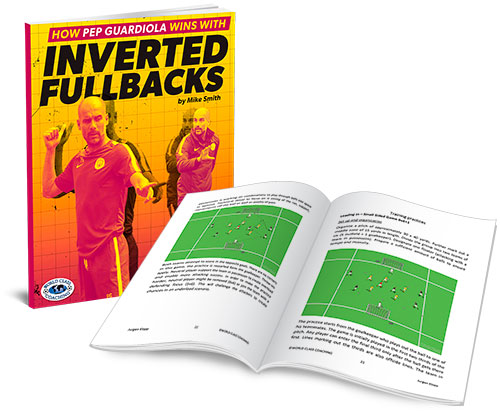
Table of Contents
PART FOUR
FLUIDITY
HOW YOUR TEAM CAN USE INVERTED FULLBACKS
BRINGING IT ALL TOGETHER
FLUIDITY
Obviously most of us do not have access to the best talent, facilities and competition in our respective leagues. Many times, these factors alone are the main contributors to the success of a system, tactic or concept. However, the use of the inverted fullback is a tactic which I feel can be used with in many formations, concepts and systems if players understand the previously listed points (conditions, advantages and weaknesses) in addition to understanding the principle of fluidity.
Previously I described Manchester City as “fluid.” I use this term to describe the ease and speed of which a team moves together seamlessly to achieve their goals – or put another way, makes the plays they need to make to win given the needs of the current situation. If I had to define fluidity beyond the text book definition (which is “a substance which has no fixed shape and adjusts easily to external pressure) I would break it down into these 5 categories:
Moving Between Defending Possessing and Attacking Shapes
Tactical Awareness of Strengths and Weaknesses of Team Formation/Style
Situational Awareness
Understanding of Risk vs Reward
Work Rate/Selflessness
Fluidity readily develops on its own in players and teams after they mature, gain experience, play with a group or within a system for an extended period of time, etc., but when broken down into the components listed above, fluidity can be taught and is certainly not a trait limited to clubs with elite levels of skill, talent or experience, i.e., your team can learn, practice and do these things and thus become more fluid.
Take the idea of moving between Defending, Possessing and Attacking Shapes. Not only are Man City scoring lots of goals this season, they are allowing few, and even fewer in the run of play. This is because they do not just leave their outside backs up in the central part of the field all the time (as we have shown, that is not what an inverted fullback is.) They typically invert only after gaining clear possession or in an attempt to gain clear possession, again, fluidly switching between defending, possessing and attacking shapes and roles. I mention this because younger players at lower levels of the game many times get fixated on positioning in terms of the area of the field they are to work in. For example, forwards who won’t work back, defenders who won’t push up or the wing mid who won’t come central. Pep Guardiola and Manchester City’s use of the inverted fullback has shown how a “ 4-3-3” – a formation which appears numbers down in the midfield – can become a potent numbers up formation at every stage of play (defense, transition, possession/attack) when all the players involved have a solid grasp of the 5 principles listed above, or Fluidity. Again, this is something which can be taught at almost every level of the game. While this is not a book on Fluidity and this concept could have been included in Chapter 2, I felt it was important enough to the inverted fullback concept to garner a chapter all its own.
Below are two clips which show this overall team “fluidity” where both backs readily drop in, protect the box with a line of 4 and wait for the right situation to come out (and most likely invert). Unlike some previous clips where the Manchester back got too aggressive or caught “in between,” here they are clearly aware of the situation and risks involved should a gambling effort fail. This is traditional zone soccer at its best and a great example of fluidity (second clip, outside backs circled in red).
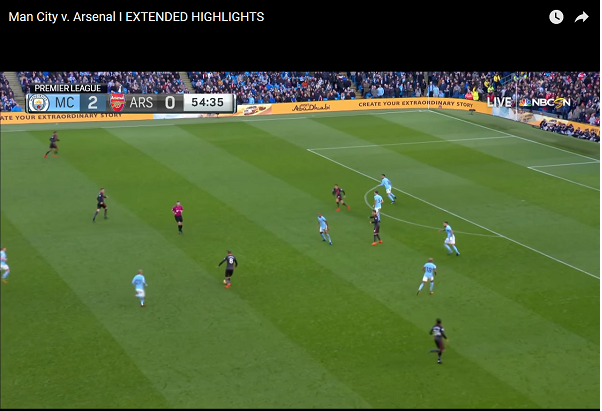
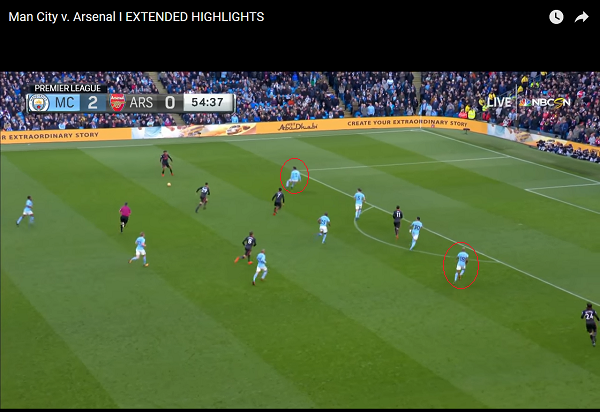
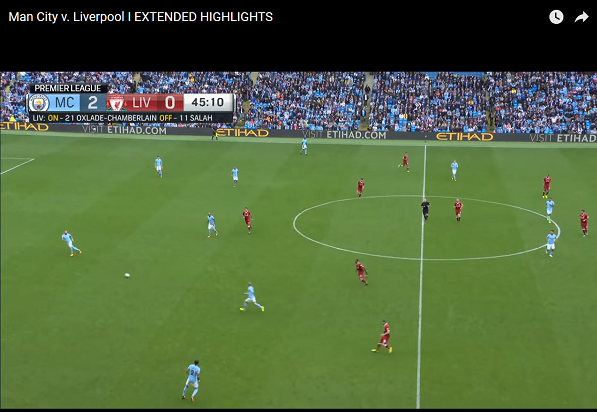
Above is another example of overall fluidity, focusing on the difference in defending, transition and possession/attacking shapes – which is also something your team can do. The situation is such as the game is in control, Manchester City has possession, so why not work into perfect passing shape? As the clip below shows 7 minutes later the focus is still on possession. Noteworthy however is how the concept of central distribution through inverted fullbacks can still be seen (next clip) as the center back has his pick of passes with Liverpool, albeit a man down, holding in the middle but not really “compact.” (This is largely due to the presence of Manchester City # 25 (below clip) holding centrally between Liverpool’s forward and midfield lines.)
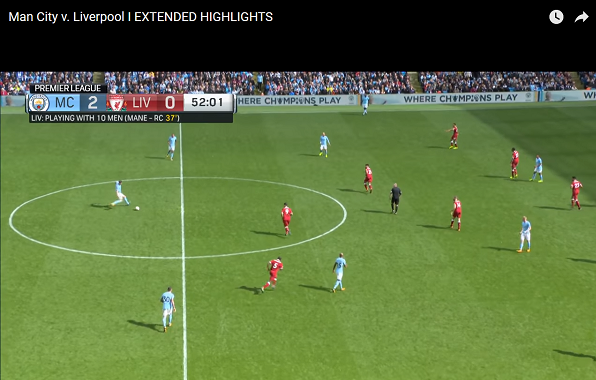
Manchester City’s match with Liverpool was their third Premier League game of the season. Liverpool did go down a man early, however, this game, for me, was a statement from the Manchester side and this game offers numerous examples of their aggressive, inverted fullback concept. The clips below shows a great example of their ability to fluidly switch from possession to aggressive attack.
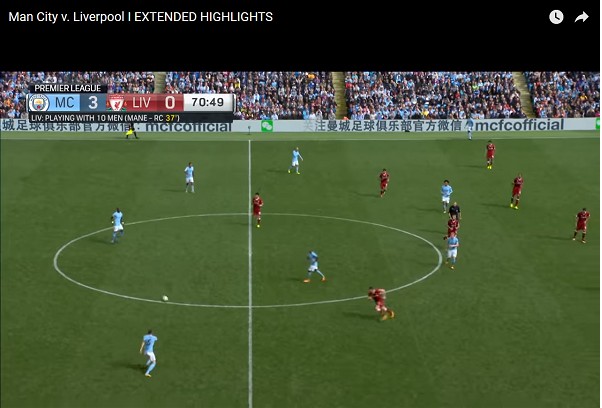
18 minutes from the previous clip, the shot above shows their continued efforts to possess the ball turning to an attempt to make an attacking run. While still maintaining width, the midfielders and forwards are starting to cheat back and in centrally.
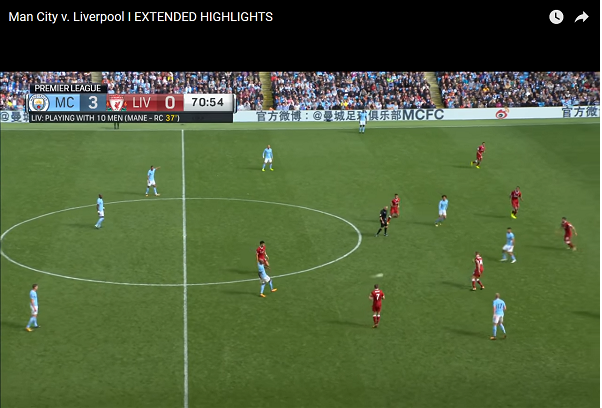
The holding mid (above center) can easily connect with the checking forward as the attack is set. Notice the Man City player at the top left pointing to the open mid and wing.
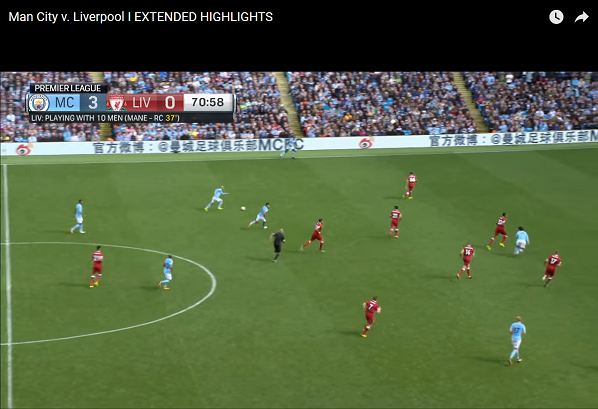
The attack is on (above)
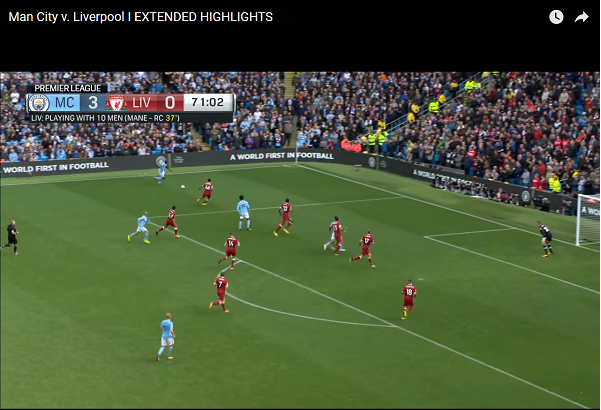
An attacking line of 5 vs 8 plus the keeper should be a win for the defending 8, but not here as every field player in the frame is facing the goal. A desperate poke foils this run for City, but 5 minutes later an almost identical attack (shown on pages 8-10) earns Manchester a goal.
There are two more clips I want to show to help drive home this idea of fluidity, and the various shapes Manchester City uses as they progress through the match with their “flying fullbacks.”
As multiple shots have shown, Manchester City will drop back and defend, and even occasionally show their stated 4-3-3 formation in the run of play. But they also use lines of 5 to create width for possession and exploit the space this width creates for aggressive attacks. The inverted fullback often starts this by forcing the opponent to attempt the impossible and defend the entire width and length of the field. The clip below shows two things. One, if the opportunity to invert is not there, and the traditional run up the wing is closed down, a reset to the keeper is always an option. This was touched on earlier and Man City does this (drops to keeper) as a matter of play/keeping numbers up, not out of desperation. More importantly however is the selfless play which is shown. Selfless play is not a huge problem in the elite levels of the game, but as touched on earlier, can be an issue in areas with low number player pools and at the youth and lower levels in general. There is a Manchester City player shown right under the timer in the top center of the screen, taking clear responsibility for the only Liverpool player who could pose an issue should Liverpool exploit a bad Man City pass or touch and win the ball. This player is a Manchester City forward. This is a total commitment to the needs of the team as a similar scenario to what happened in the West Brom match (seen previously) could have spelled disaster early for Man City in this game.
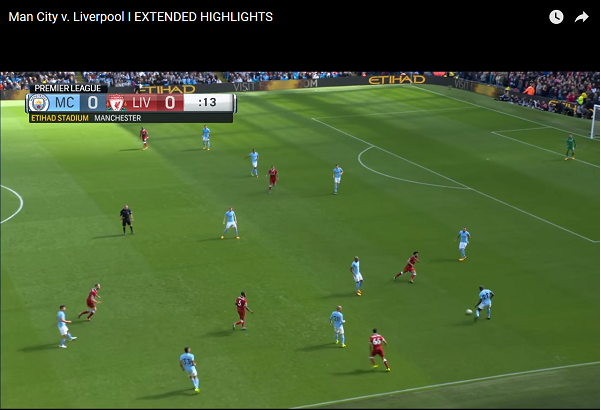
Many of the topics covered so far are not on their own new to the game. Pep Guardiola himself has used many of these similar tactics and ideas in his previous coaching stops. What is new is the efforts to which Manchester City has gone to impose their will on their opponents from the opening whistle to the last. This battle to impose one’s will is, after all, at the heart of any competition and the use of the inverted fullback is Manchester’s main vessel for this.
I feel like many coaches are saying “What? He is not leaving his outside defenders back there in case we counter or run up the wing?” or “ What? They are not working the ball around the back until they choose a side to run up and hit their cross from?”
Manchester City has clearly successfully bucked conventional wisdom. For me, underlying the aggression and tactical goals is their mastery of the concept of fluidity.
HOW YOUR TEAM CAN USE INVERTED FULLBACKS
I will admit to being one of those coaches who yells “wide” a dozen times a game. I have purposely steered teams away from the center of the field, especially on my own end, not because I don’t understand the distributive advantages of the middle or the value of possession, but because I wanted to avoid turnovers/getting countered and the unpredictable back and forth involved when youth and high school players try to “force play right down the pipe.” I have used sound conventional logic to explain this to my teams: “If we get the ball out wide, good defensive teams will fall in center so we want to work around that area and try to draw them out.” The bulk of my coaching has come at the high school and club levels but I have had the opportunity to spend time with a couple successful NAIA Men’s programs and one NCAA Division I Women’s program and have seen this same logic played out there as well. Obviously, after writing this book, I am considering how I can use an inverted fullback on my team. Following is how I plan to do it, including a few exercises which will help your team implement/teach the concept if you choose to try playing with an inverted fullback as well.
1. Analyze My Current System/Style and Player Pool
Most successful teams find and play to their strengths. I personally prefer to run 3 attackers but have always struggled to have players who could defend and/or run the midfield with only 3 players. Every season is a search to find the right balance between what I want to do and what my team can do. This has to be the first step in any tactical/style of play adjustment and as stated previously, Manchester City is no different. Without their strong central backs, their disciplined holding mid, their mobile mids, and selfless forwards, there would be very little discussion about their inverted fullbacks. After a great high school season this year, my biggest team need is actually learning to possess the ball more effectively and we only graduated 2 seniors from a core group of 14 players. We tied the school record for second most goals scored in a season, we were not shut out, had 5 players with double digit goals but only one player with double digit assists. This is not a book about my own soccer team of course, I am just using my situation as an example of a team which is set up to absolutely benefit from the advantages playing an inverted fullback can bring, at least in some situations. The first step has to be taking a moment to decide if using an inverted fullback is right for your team.
2. Answer This Question: How Can I Coach the Principles of Fluidity?
- Moving Between Defending/Possessing and Attacking Shapes
- Tactical Awareness of Strengths and Weaknesses of Team Formation/Style
- Situational Awareness
- Understanding of Risk vs Reward
- Work Rate/Selflessness
A better heading is perhaps, “What Can I Do to Coach the Principles of Fluidity?” While there are specific drills and activities a coach can use to work on these aspects (and I will include some here) many of these principles can be added to existing exercises as well. For example, simply put your players in situations where they have to make a choice. For example:
Pass/Move/Communicate
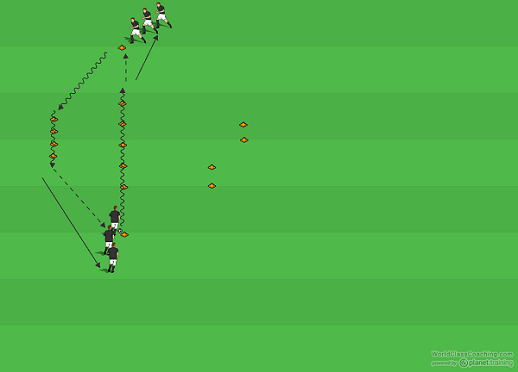
To help assess situational awareness, work rate/ethic and selflessness, set up a basic cone dribble with 3 lines (as shown). Each line will be different than the others, with one (shown center) obviously involving more work than the other two. Do not tell the players which line they have to dribble through, let them pick. The only instruction is for them to dribble as quickly as they can through the line, pass to the player in the next line and then go to the back of the line they passed to. Encourage the group (6 to 8 players) to work hard and keep the ball moving. What will your players do? Will they avoid the line with the most work? Will they rotate? If there is a bad pass will they take the ball toward the closest line to keep it moving or stop and turn and take the easy route. This same principle of choice can be applied to many different activities and provides for both the assessment and teaching of work rate/ethic and selflessness in addition to situational awareness. Having them demand the ball and constantly encourage their team mates during the entire drill will help with their overall willingness and ability to communicate.
Here is another way to make sure the players are constantly on the ball, moving off the ball, and communicating. Instead of the traditional passing lines used in warm ups, try this:
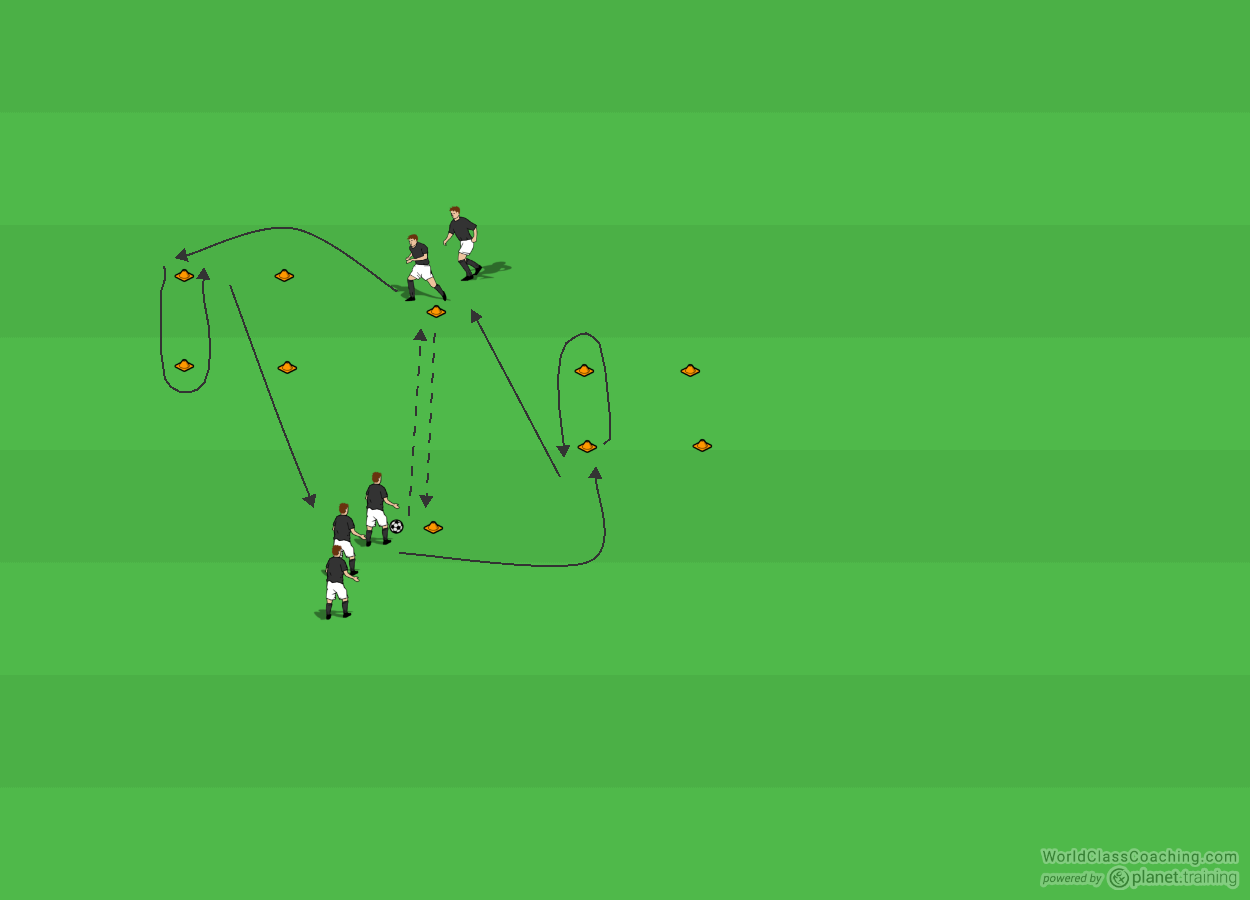
Line 5 players up as shown. Instead of just passing and following their pass have the players pass, check to the cone grid, run up and back around two cones (as shown) and then check to the next line while demanding the ball, regardless if they are up to receive it or not. With 5 players and 4 cone lines to check to, there should never be a player who is not on the ball, moving off the ball or communicating. Small changes like this help to increase a players’ work rate and transitional speed/abilities.
Enough cone dribbling? Here is game in which every aspect of fluidity can be assessed, taught, practiced and perfected, and it also introduces a formational component which will help in using an inverted fullback.
7 v 7 with Assigned Marks
On a half field, set up two teams of 7 plus keepers and let them play. The team whose goal is at the half line in the center circle (as shown) will be the team keeping the wider, two diamond shape. The other team will set up in a 4-2-1. Keepers must stay in their boxes, with the center circle serving as that keeper’s box. There is one catch. Assign each player a mark who is the only player which can actively tackle and engage them. All players may shadow/jockey and all players may steal passes but players can only challenge/tackle the ball away from their assigned mark. Every aspect of fluidity is in play here.
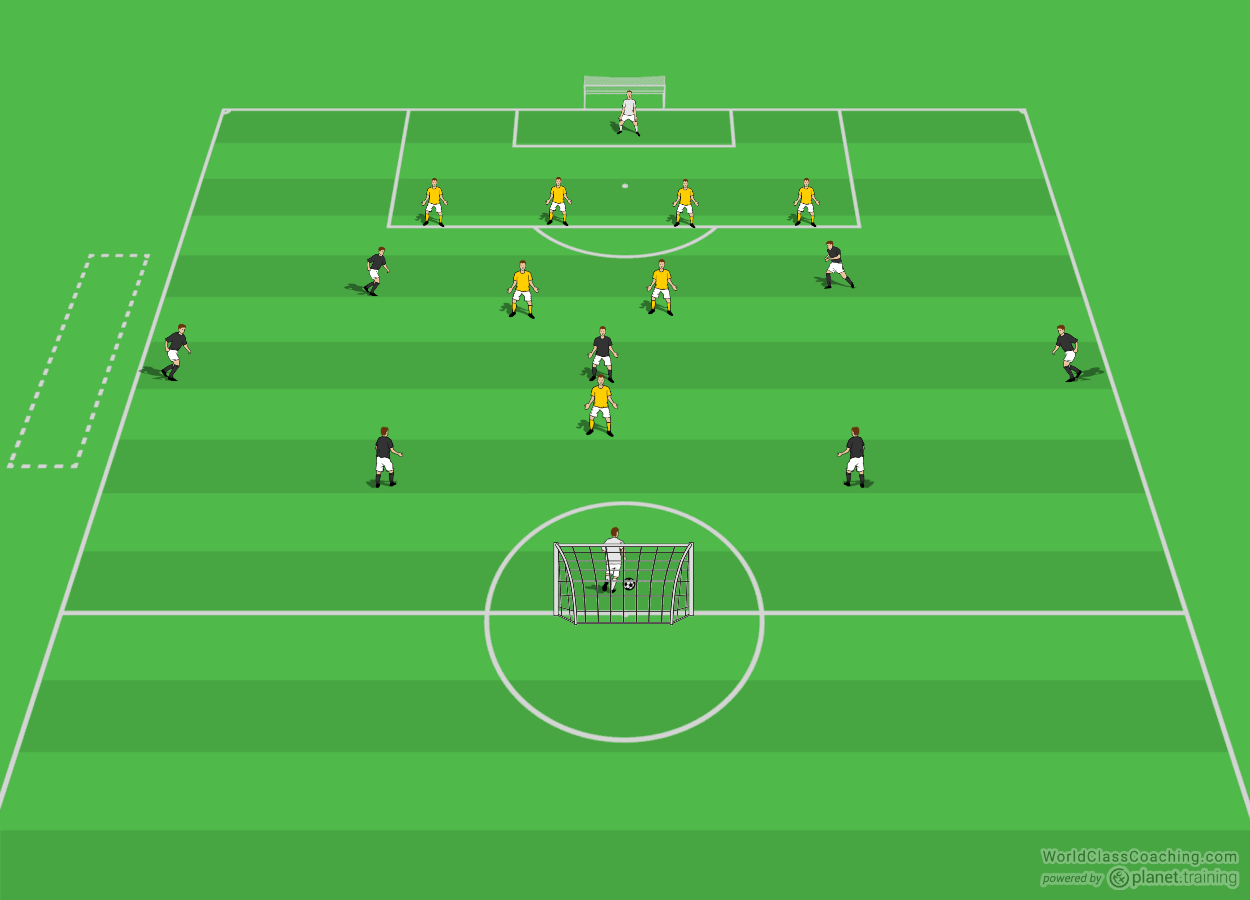
In addition to working on the concept of fluidity, obviously there are drills which work purely on the tactical aspects of using an inverted fullback. Here are 3:
6 v 3 Zone with Wings
Set up a 35 – 40 yd wide by 30 yd long cone grid (as shown). Designate goals on one end with flags or posts. The goals are for the defending teamn(yellow). Set up zones to designate each wing. The defending team places one player in each wing zone, and 3 in the central zone. The attacking team has 6 players in the central zone, but designates two players (in red) who may enter the wing zones once the defending team has the ball there; one red player per zone to create a 1 v 1 in the wide space. This drill simulates much of what playing an inverted fullback is about, creating numerical advantages. In a game, IF the possessing/attacking team has 7 players in the center of the field, the defending team will be forced to adjust their shape, most likely bringing their wings in, or will allow dangerous possession. In this drill, set a goal of 20, 30 or 50 passes for the attacking team. IF the defending team gets the ball, they can score on either of the wings by dribbling through the posts. The attacking team can send in one player, simulating the inverted back trying to get back and recover to stop the counter.
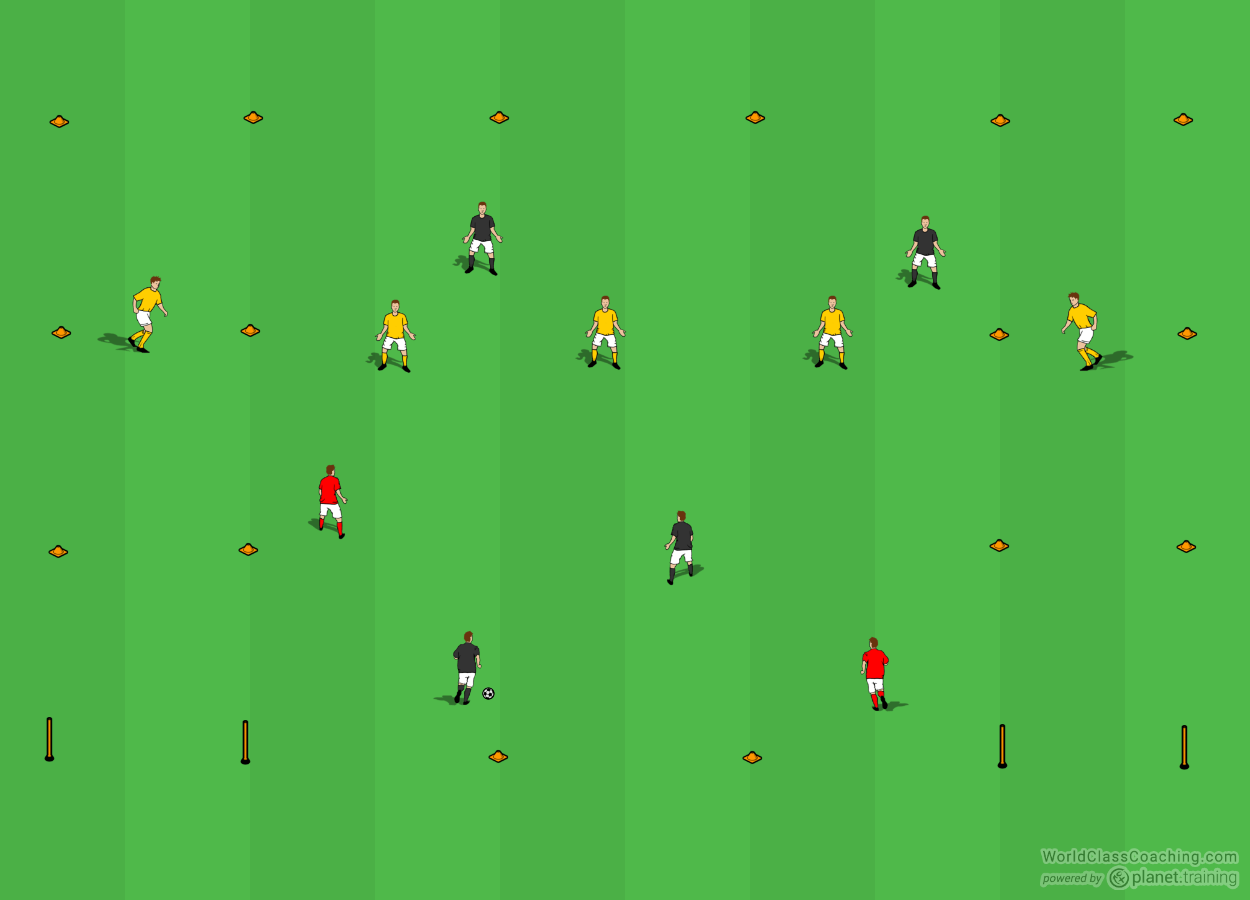
5 v 5 Plus Keeper and Target
The focus in the drill below is on the defending team (yellow) and how they transition from defending to playing out. The attacking team (black) starts with the ball in the center circle and should actively try and score. IF the defending team wins possession or there is a goal kick, they should attempt to widen their shape (which includes the keeper being available for a drop/switch) and possess for a chance to hit their target player, who can check back but must stay within 10 yards of the half line (second diagram).
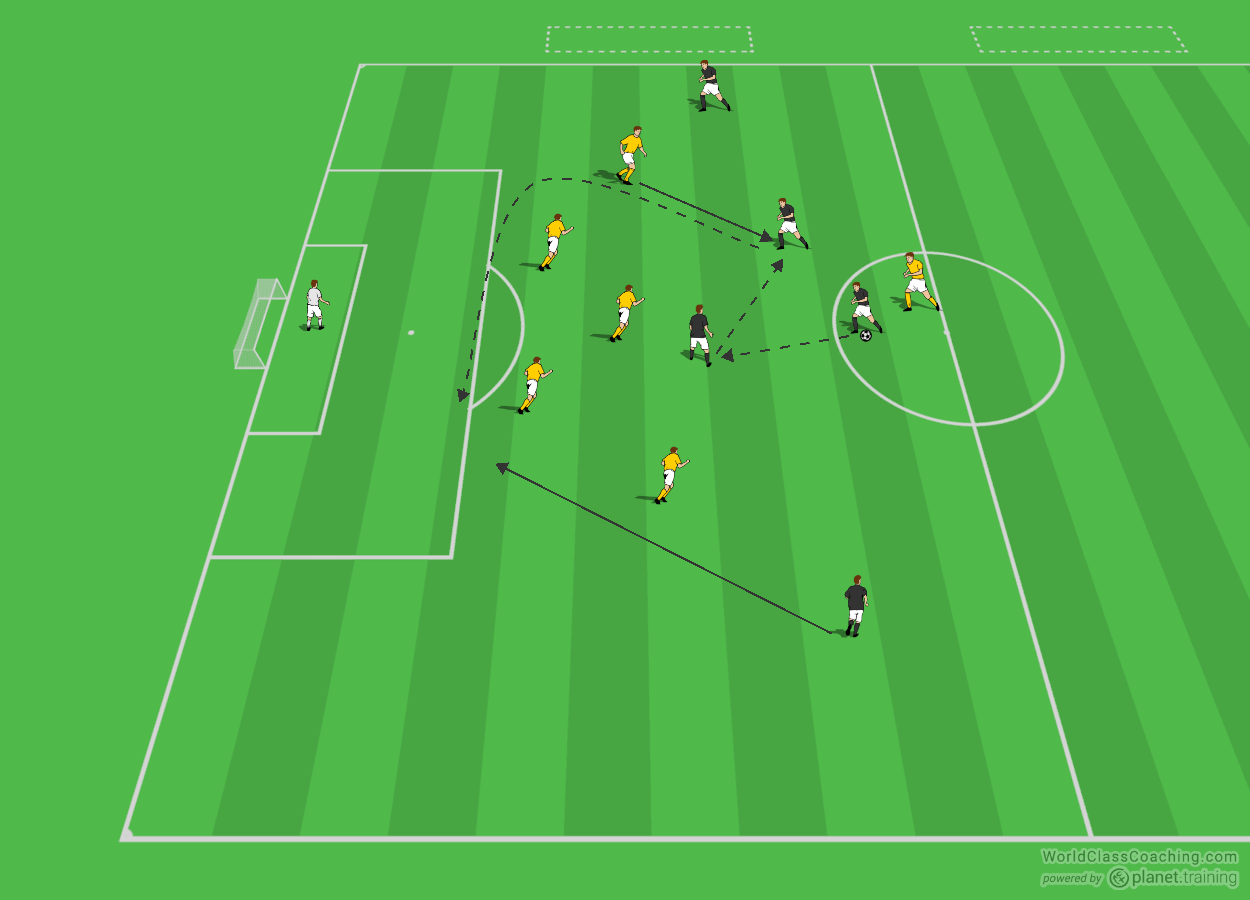
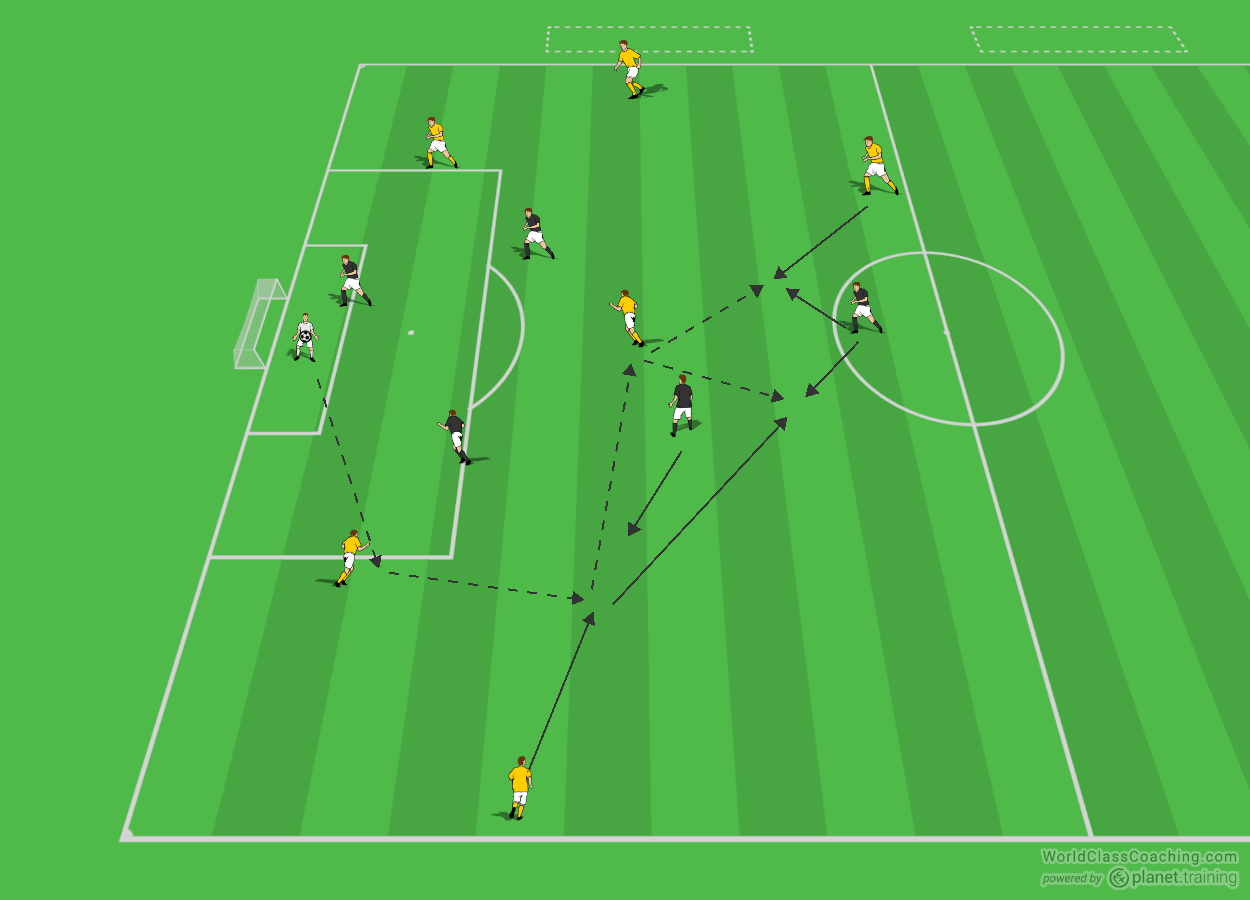
As seen previously, playing out this way if the first step in creating the space for the inverted full back to use.
Forward Check Down for Numbers Up
Again on a half field, play 8 attackers plus a keeper against a team of 8 who will be defending 3 stick goals (as shown). Place stick goals on the half line in the left, center and right sections of the field to give the attacking team 3 targets for scoring, they must however dribble through to score. Play starts with a goal kick and the attacking team should simulate both the wide W shape to start and the inverting fullback as play progresses. The forward should check back in for support and just like in a real match, the attacking team should seek to create numbers up through triangle spacing (next diagram).
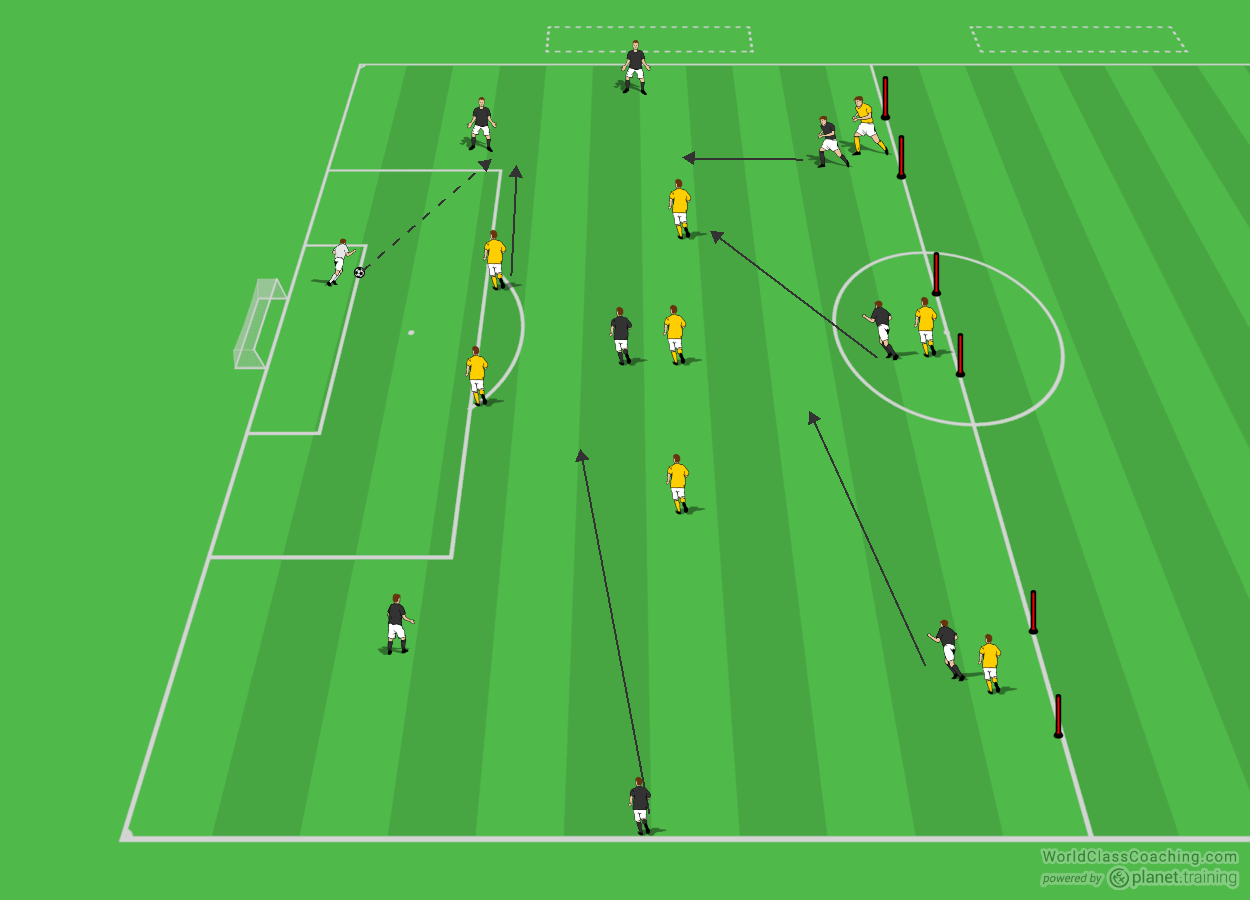
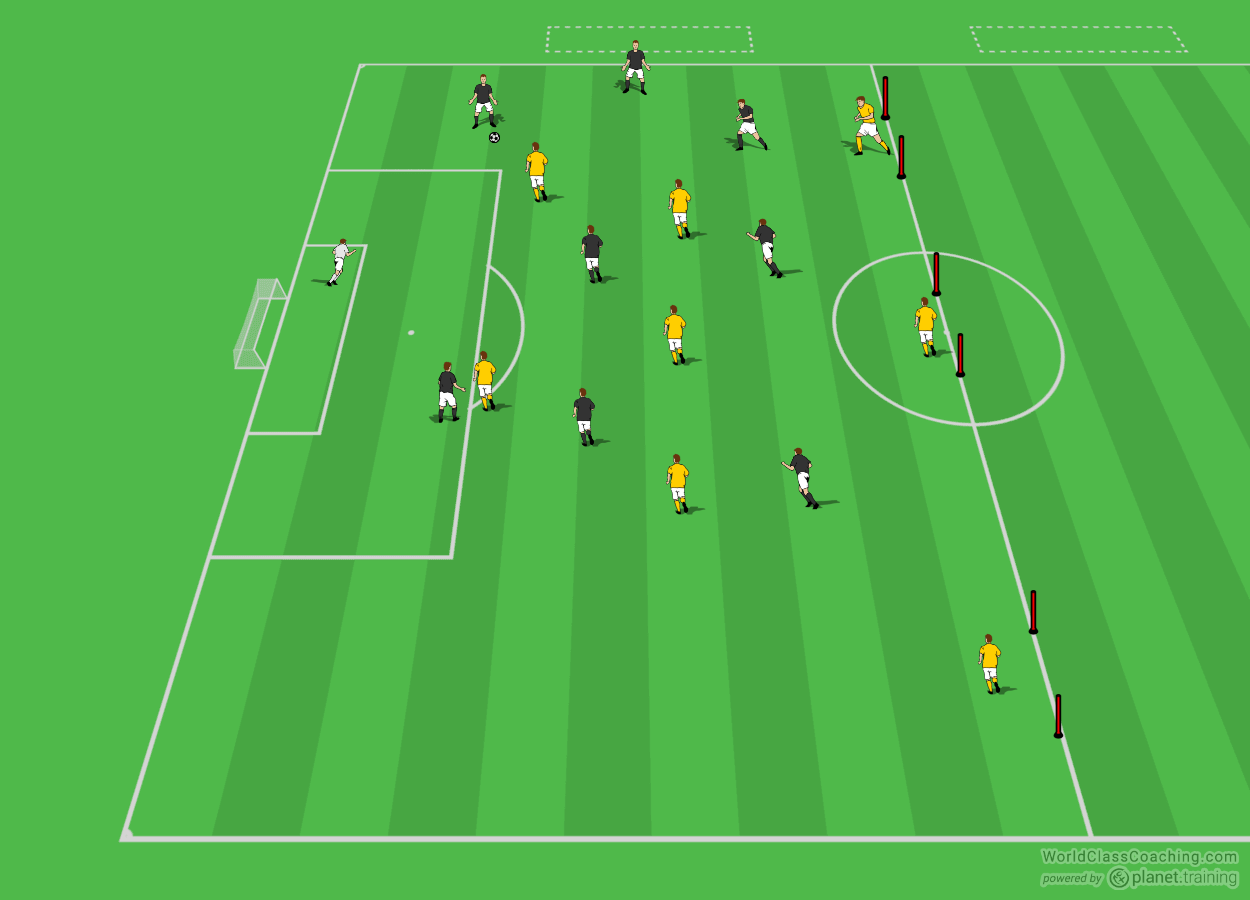
As play shifts, the focus is on possession and numbers up movement as a unit to open the space between the sticks. Just like in a match, if the defending players covering the stick goals choose to stay up, the attacking team should have tons of possession with a 9 v 5.
BRINGING IT ALL TOGETHER
As of this writing, Manchester City have 14 wins and 1 draw in their first 15 Premier League Matches. They have scored 46 goals and allowed only 10. Their use of the inverted fullback has been the catalyst for this start and to date they have shown no signs of letting up.
Playing with or allowing your fullbacks to invert is an aggressive tactic which comes with some risk. However, when combined with the tactical and formational support shown in Manchester City’s approach, there are advantages as well.
While the need for total team buy in and fluidity is important to the inverted approach, these are concepts which can be taught, learned, practiced, and perfected. With a focus on the tactical advantages as far as possession and attacking options by implementing the inverted fullback, your team could gain an advantage in your league, similar to the one Manchester City has gained in theirs.
Good luck!
References
Pep Guardiola’s Flying Full-Backs Expose Chelsea’s Vulnerability – Jonathon Wilson
The Guardian On Line, 10-01-2017
Manchester City vs. Manchester United Match Re-Cap
Dailymotion via Soccer Blog, 11/02/2014
Manchester City vs. West Bromwich Albion
Man City You Tube, 9/21/2017
NBC Sports EPL Extended Highlights
You Tube 2017


